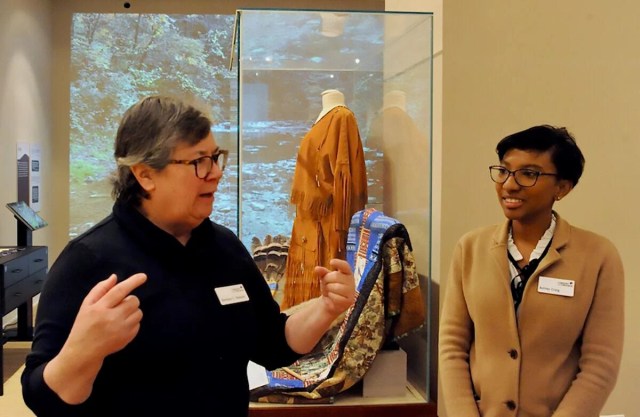RICHMOND — Nestled in the rear of the Library of Virginia in Richmond lies a modest exhibit with a lofty goal: aiding tribal communities residing in the state in narrating their contemporary life stories.
The “Indigenous Perspectives” display at the library diverges from showcasing the historical life of tribes in pre-colonial times, a narrative often depicted in other museums like the Virginia Museum of History & Culture in Richmond. Instead, this exhibit delves into the post-European arrival era, highlighting the enduring presence of Indigenous people despite facing near erasure at various junctures. It sheds light on the current realities of these communities and their preferences on storytelling.
Chief Steve Adkins of the Chickahominy Tribe, in one of the video interviews featured in the exhibit, articulates the significance of identifying as an American Indian rather than merely a person of color. He emphasizes the value of being recognized for both differences and commonalities, rejecting colorblindness in favor of mutual respect.
Dispelling the misconception that Indigenous people had vanished from Virginia by statehood, Barbara C. Batson, the exhibit coordinator at the Library of Virginia, asserts the contrary based on substantial historical records at the library’s disposal.
The initiative to collect these documents began about three years ago following dialogues with tribal representatives. What started as an effort to enhance the education on Indigenous history for teachers evolved into a comprehensive archival endeavor. The library’s vast collection, comprising over 130 million printed resources spanning centuries, revealed a trove of letters, artifacts, and legal papers showcasing tribal activities such as correspondence with governors and engagement in legal proceedings.
These historical documents have proven pivotal for tribal leaders seeking federal and state recognitions, a process that gained momentum with the passage of the Thomasina E. Jordan Indian Tribes of Virginia Federal Recognition Act in 2018. The collaboration between library staff and tribal leaders underscored the importance of letting the Indigenous voices shape their narrative.
The “Indigenous Perspectives” exhibit, unveiled in December and running until mid-August, encapsulates the outcomes of these collaborative efforts. Central to the exhibit are video narratives shared by tribal members, offering insights into the continuity and evolution of tribal identities. Additionally, maps, documents, and tribal artifacts on display, accompanied by interpretive language developed with tribal input, provide a nuanced portrayal of Indigenous heritage.
The exhibit also explores lesser-known facets of history, such as the presence of Indian schools across Virginia and the establishment of a Federal Indian Boarding School in Hampton Roads. These initiatives aimed at assimilating Indigenous children into mainstream American culture have recently come under scrutiny for their detrimental intergenerational impacts.
By showcasing artifacts and narratives that underscore the tribes’ enduring connection to the land and their cultural practices, the exhibit highlights the resilience and stewardship of Indigenous communities. It emphasizes the importance of recognizing and learning from Indigenous perspectives on environmental interactions, offering valuable insights for broader societal discussions.
For those keen on delving deeper into Indigenous narratives, the exhibit serves as a gateway to understanding not just the past but also the contemporary efforts to preserve and celebrate Indigenous cultures in Virginia.
If you plan to visit
The Library of Virginia, situated at 800 E. Broad St. in Richmond, welcomes visitors to explore the exhibit from Monday to Saturday, 8:30 a.m. to 5 p.m., until Aug. 17. Admission and parking are complimentary.
Apart from the library exhibit, several other venues in Virginia offer opportunities to engage with Indigenous stories and heritage:
- Patawomeck Museum and Cultural Center in Stafford: Features artifacts, a living village, and events. Open every first and third Saturday from April to October, 10 a.m. – 2 p.m., with general admission at $10.
- Monacan Indian Nation Museum in Amherst: Showcases artifacts, a historical Indian mission school, and items for sale. Open Tuesday through Sunday, 10 a.m. – 3 p.m., except on the third Saturday of every month, with general admission priced at $5.
- Historic Jamestown: Offers a re-creation of the first English settlement in North America and insights into early interactions between Indigenous peoples and European settlers. Admission is free, open daily from 9 a.m. to 5 p.m.
- Gloucester County Visitor Center in Gloucester: Features a Werowocomoco exhibit and provides tourist information, with free admission. Open Tuesday through Saturday, 10 a.m. – 4 p.m., and Sunday and Monday, 1 p.m. – 4 p.m.
- Jamestown Settlement: Showcases a museum and outdoor living history areas exploring the convergence of Powhatan, English, and West Central African cultures in the early 1600s. Admission: \(18 for adults, \)9 for children, open daily from 9 a.m. to 5 p.m.
- Machicomoco State Park in Hayes: Located on ancestral tribal lands associated with the Powhatan alliance, this state park is dedicated to Virginia’s Indigenous peoples, with parking priced at $5.
- Virginia Museum of Fine Arts in Richmond: Exhibits Native American art from Virginia and beyond, with free admission. Open Saturday through Tuesday, 10 a.m. – 5 p.m., and Wednesday through Friday, 10 a.m. – 9 p.m.
